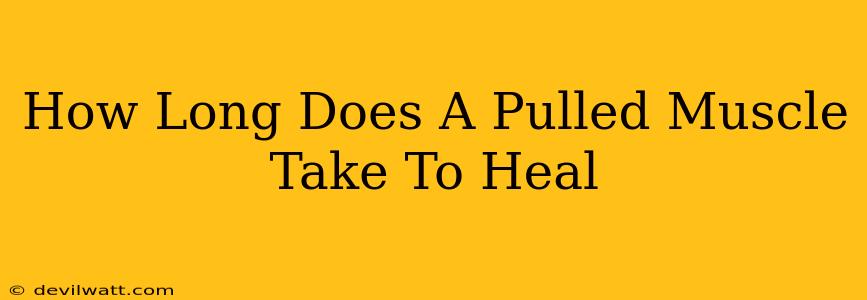Pulling a muscle, also known as a muscle strain, is a common injury that affects people of all ages and activity levels. Understanding the healing process is crucial for proper recovery and preventing future injuries. This guide explores the factors influencing healing time and provides tips for faster recovery.
Understanding Muscle Strains
A pulled muscle occurs when muscle fibers are stretched or torn. The severity of the strain determines the healing time. Strains are typically graded on a scale of 1 to 3:
- Grade 1: Mild strain with minimal muscle fiber tearing. You might experience mild pain and tenderness.
- Grade 2: Moderate strain with more significant muscle fiber tearing. Pain is more noticeable, and you might experience some swelling and bruising.
- Grade 3: Severe strain with a complete tear of the muscle. This often results in significant pain, swelling, bruising, and potential loss of muscle function.
How Long Does it Take to Heal?
Unfortunately, there's no single answer to this question. The healing time for a pulled muscle varies greatly depending on several factors:
Factors Affecting Healing Time
- Severity of the strain: As mentioned above, Grade 1 strains heal faster than Grade 2 or Grade 3 strains.
- Location of the injury: Some muscle groups heal faster than others due to differences in blood supply and tissue type.
- Age and overall health: Younger individuals generally heal faster than older individuals. Underlying health conditions can also impact healing time.
- Treatment and rehabilitation: Following a proper treatment plan, including rest, ice, compression, and elevation (RICE), and engaging in appropriate physical therapy, significantly impacts recovery speed.
- Individual healing capacity: Everyone heals at a different pace. Genetics and overall health contribute to this variation.
Typical Healing Timeframes:
While these are just estimates, you can generally expect:
- Grade 1 strain: 1-2 weeks
- Grade 2 strain: 3-6 weeks
- Grade 3 strain: 6-8 weeks or longer; may require surgery in severe cases
It's crucial to remember that these are just averages. Always consult a doctor or physical therapist for an accurate diagnosis and personalized treatment plan.
Speeding Up the Healing Process
While you can't magically speed up the natural healing process, you can take steps to optimize recovery:
- RICE method: Rest the injured muscle, apply Ice to reduce swelling, use Compression to minimize inflammation, and keep the injured area Elevated.
- Over-the-counter pain relievers: Ibuprofen or naproxen can help manage pain and inflammation.
- Physical therapy: A physical therapist can develop a customized exercise program to improve flexibility, strength, and range of motion.
- Avoid strenuous activity: Return to activity gradually, avoiding activities that exacerbate the injury.
- Maintain a healthy diet: Proper nutrition provides your body with the building blocks it needs for repair.
- Get enough rest: Adequate sleep is crucial for tissue repair.
When to Seek Medical Attention
While many pulled muscles heal with home care, consult a doctor or physical therapist if you experience:
- Severe pain
- Inability to use the affected muscle
- Significant swelling or bruising
- Numbness or tingling in the affected area
- Persistent pain after several weeks
Conclusion
The healing time for a pulled muscle varies greatly depending on several factors. While rest, ice, and gentle movement are key to recovery, seeking professional medical advice is crucial for accurate diagnosis and a personalized treatment plan. By following a proper recovery program, you can minimize healing time and return to your normal activities as quickly and safely as possible. Remember that patience and consistency are key to a successful recovery.

